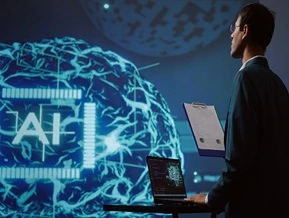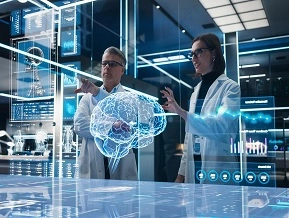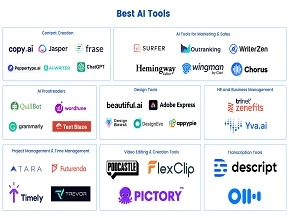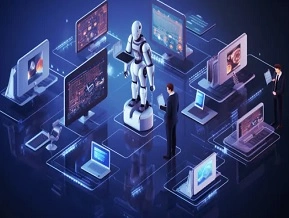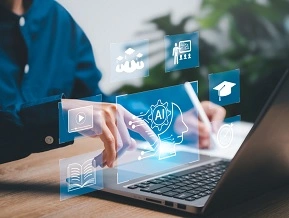Emerging Trends & Innovations in Artificial Intelligence: What to Expect in 2025?
What Does the Landscape of AI Look Like in 2025?
Artificial Intelligence (AI) has undergone an extraordinary transformation over the past few years. From foundational breakthroughs to mainstream applications, the evolution between 2020 and 2024 has reshaped the way we live, work, and learn.
Evolution of AI: 2020 to 2024
In just five years, AI has progressed from rule-based systems and narrow applications to highly adaptive models capable of understanding natural language, generating content, and making complex decisions. The release of advanced models like GPT-4 and the emergence of multimodal systems that combine text, images, and video have pushed the boundaries of machine intelligence. These years also witnessed a surge in the integration of AI into everyday tools, from virtual assistants to enterprise software.
Key Milestones that Shaped the Future
Several critical milestones have defined this rapid development. Notably, open-source AI frameworks became more accessible, leading to faster experimentation and innovation. Breakthroughs in generative AI, such as image generation and human-like conversation, made headlines. Additionally, ethical AI discussions gained momentum, prompting the creation of international guidelines and responsible AI practices. These milestones laid the foundation for the advanced, responsible, and human-centric AI applications we see in 2025.
The Role of Online Learning and Global AI Education
As AI technologies advanced, the demand for skilled professionals surged. Online learning and global AI education became vital in bridging the skills gap. Platforms offering AI courses, coding bootcamps, and certifications helped democratize access to knowledge, allowing individuals worldwide to participate in the AI revolution. In 2025, these learning platforms continue to play a crucial role in preparing a diverse and competent workforce to support the ever-growing AI ecosystem.
What are the Emerging Trends & Innovations in Machine Learning?
Emerging Trends & Innovations in machine learning are driving a new wave of smarter, more adaptable, and responsible AI systems in 2025. These developments are not only improving performance but also addressing critical challenges like data privacy, model size, and energy efficiency.
Self-Supervised and Few-Shot Learning Take Centre Stage
One of the most exciting developments is the rise of self-supervised and few-shot learning. Unlike traditional supervised models that rely on massive labelled datasets, these new approaches allow machines to learn from unlabelled or minimal data. This capability makes AI more scalable, particularly in fields where data labelling is expensive or impractical—such as healthcare, legal, and scientific research.
Federated Learning Enhances Privacy and Security
As data privacy becomes increasingly vital, federated learning has gained traction. This decentralized approach allows models to be trained across multiple devices or servers without moving the data itself. As a result, sensitive user information remains local while still contributing to improving the model's intelligence. This innovation is especially impactful in sectors like finance and healthcare, where compliance and confidentiality are paramount.
More Efficient and Eco-Friendly Transformer Models
Transformer models remain the backbone of modern AI, but their high computational cost has been a concern. In response, researchers are now focusing on optimizing these models to reduce energy consumption and carbon footprint. Advances such as sparsity techniques, parameter sharing, and adaptive computation are making transformers faster, smaller, and greener.
Compression and Optimization for Real-World Use
Another key trend is AI model compression and optimization. Techniques like quantization, pruning, and distillation are enabling deployment on edge devices like smartphones and IoT systems without sacrificing accuracy. This is accelerating the real-world applicability of machine learning across industries.
What are the Trends and Innovations Emerging in Natural Language Processing (NLP)?
Trends and Innovations emerging in Natural Language Processing (NLP) are transforming how machines understand and interact with human language in 2025. From multilingual communication to emotionally aware AI, NLP is expanding the boundaries of what language technologies can achieve.
Breakthroughs in Multilingual and Zero-Shot Translation
Recent advancements have significantly improved multilingual and zero-shot translation capabilities. NLP models can now translate between languages with little to no prior training on specific language pairs, opening up communication across previously underserved languages. These models leverage massive multilingual datasets and transformer architectures to provide accurate, context-aware translations in real time, enhancing global collaboration and accessibility.
Real-Time Voice Assistants with Emotional Intelligence
Voice assistants have evolved far beyond basic commands. Modern systems can now detect emotion and understand user intent, making interactions more natural and human-like. This innovation is made possible by combining sentiment analysis, prosody recognition, and advanced contextual modelling. Whether it’s a digital assistant offering empathetic responses or an AI agent adjusting tone in customer interactions, emotional recognition is becoming a core part of conversational AI.
NLP Powering Education, Content, and Customer Engagement
NLP’s impact is particularly notable in sectors like education, content creation, and customer service. In education, intelligent tutoring systems and AI-driven feedback tools help personalize learning experiences. Content creators use NLP tools for everything from idea generation to grammar correction and SEO optimization. In customer service, chatbots and virtual agents equipped with NLP reduce response time and improve satisfaction by delivering instant, relevant support.
What are the merging Trends & Innovations in AI for Business Automation?
In 2025, emerging trends & innovations in AI for business automation are reshaping the corporate landscape by streamlining operations, improving accuracy, and enabling smarter decision-making across departments. From marketing strategies to HR workflows, AI is powering a new era of efficiency and intelligence.
AI-Driven Decision-Making Across Key Functions
Artificial Intelligence is becoming an integral part of decision-making in business functions like marketing, HR, and finance. In marketing, AI tools analyse customer data to predict trends, personalize campaigns, and optimize ad spending. HR departments use AI for talent acquisition, employee engagement analysis, and performance forecasting. Meanwhile, finance teams rely on AI for fraud detection, risk management, and real-time financial analytics. These intelligent systems help leaders make faster, data-backed decisions that drive growth.
Intelligent Document Processing and RPA
One of the most impactful innovations is intelligent document processing (IDP), which uses AI to extract, classify, and manage data from structured and unstructured documents. When combined with Robotic Process Automation (RPA), businesses can automate repetitive, rule-based tasks such as invoice processing, compliance checks, and data entry. This reduces manual effort, minimizes errors, and frees up employees to focus on higher-value work.
AI Copilots Empowering Knowledge Workers
AI copilots—virtual assistants designed to support professionals—are becoming essential tools for knowledge workers. These systems help draft emails, summarize reports, generate insights from data, and assist in software development. By integrating seamlessly into daily workflows, AI copilots enhance productivity and support decision-making without replacing the human touch.
What are the Trends and Innovations Emerging in Generative AI?
From creating lifelike videos to composing original music, generative AI is expanding its influence far beyond the written word.
Expanding Horizons: From Text to Video, Music, and 3D Design
While generative AI gained early traction through text generation, it has now rapidly progressed into other media formats. Models like text-to-video generators, AI music composers, and 3D object creators are being adopted across industries such as entertainment, gaming, architecture, and advertising. These tools enable users to generate high-quality visual and audio content with minimal technical skills, dramatically reducing production time and cost.
The Rise of Personalized AI Content Creators
A key innovation in 2025 is the emergence of personalized AI content creators. These systems learn from individual user preferences, tone, and style to generate tailor-made content—from blog posts and product descriptions to social media updates and video scripts. Businesses, influencers, and educators are leveraging these tools to engage audiences more effectively and at scale, driving efficiency without sacrificing authenticity.
Navigating Ethical Implications and Detecting Authenticity
As generative AI becomes more powerful, concerns around ethical use, misinformation, and deepfakes are growing. This has led to increased focus on content authenticity detection—AI tools that can verify the origin of content and identify whether it was human-made or AI-generated. At the same time, developers are embedding ethical guardrails into AI systems to ensure responsible use, especially in sensitive areas like journalism, education, and politics. The trends and innovations emerging in generative AI are revolutionizing creative processes while also prompting critical conversations about trust, transparency, and accountability in the digital age.
What are the Emerging Trends & Innovations in AI Hardware?
Emerging trends & innovations in AI hardware are playing a pivotal role in accelerating artificial intelligence performance while meeting the growing demands of mobility, efficiency, and real-time computation. In 2025, the AI hardware ecosystem is evolving rapidly to support smarter devices and sustainable processing.
Rise of Custom AI Chips: TPUs, GPUs, NPUs, and Edge Accelerators
One of the most significant shifts in AI hardware is the development of custom chips optimized for AI workloads. Tensor Processing Units (TPUs), Graphics Processing Units (GPUs), and Neural Processing Units (NPUs) are being engineered specifically for deep learning tasks, improving speed and efficiency. In addition, edge AI accelerators are enabling real-time inference on devices like smartphones, drones, and industrial sensors—eliminating the need for cloud processing and reducing latency.
Energy-Efficient AI for Mobile and IoT
With billions of connected devices worldwide, energy efficiency has become a top priority. New AI chips are designed to deliver high-performance computing while consuming minimal power. These advancements are critical for mobile devices, smart home systems, and Internet of Things (IoT) applications, where prolonged battery life and responsive performance are essential. Techniques like quantization, model pruning, and efficient on-chip memory use are helping reduce power consumption without compromising capability.
AI-Enabled Wearables and Assistive Tech
Wearable technology is becoming more intelligent thanks to AI hardware integration. From fitness trackers that monitor health in real time to smart glasses that assist the visually impaired, AI-powered wearables are delivering meaningful, life-enhancing experiences. These devices rely on specialized chips that support continuous sensing, analysis, and user interaction—making AI more personal and accessible than ever before.
What are the Trends and Innovations Emerging in Ethical & Responsible AI?
Explainable AI (XAI) in High-Stakes Industries
Explainable AI, or XAI, is gaining strong momentum, especially in regulation-heavy sectors like healthcare, banking, and insurance. These industries require clear justifications for AI-driven decisions to meet compliance standards and build user trust. XAI frameworks make AI decision-making processes more interpretable, allowing stakeholders to understand how and why specific outcomes are reached—an essential step toward building reliable, human-aligned systems.
Bias Detection and Mitigation: A Growing Priority
Uncovering and addressing bias in AI models has become a top priority for developers and organizations. Emerging frameworks now incorporate bias audits, fairness metrics, and real-world scenario testing into AI development pipelines. These tools help detect discriminatory patterns based on gender, race, age, or other sensitive attributes, ensuring that AI systems operate equitably. In 2025, integrating ethical checks into the model lifecycle is seen as a baseline requirement rather than an optional feature.
Global Push for AI Governance and Transparency
Countries and international coalitions are moving toward comprehensive AI governance. From the EU AI Act to industry-specific guidelines, regulatory efforts aim to enforce transparency, safety, and accountability. There’s also a growing emphasis on open AI reporting, where organizations disclose data sources, model limitations, and usage contexts to promote responsible innovation.
In summary, the trends and innovations emerging in ethical & responsible AI reflect a crucial shift toward building AI systems that are not only powerful but principled, inclusive, and aligned with societal values.
What are the Emerging Trends & Innovations in AI Education and Workforce Development?
In AI education and workforce development are reshaping how people learn, adapt, and thrive in an increasingly AI-driven world. From schools to professional settings, the focus is shifting toward creating more intelligent, inclusive, and personalized learning experiences.
Adaptive Learning and Personalized AI Tutoring
One of the most impactful developments in education is the rise of AI-powered adaptive learning systems. These platforms use real-time data to adjust content based on each student’s pace, strengths, and areas of difficulty. AI tutors can now provide individualized feedback, simulate one-on-one instruction, and even detect when a student is struggling emotionally. This personalization not only improves academic outcomes but also builds confidence and engagement.
Upskilling Through Online AI Platforms
As the demand for AI skills grows across industries, online platforms like Learn Artificial Intelligence (LAI) are becoming essential tools for upskilling. These platforms offer flexible, accessible courses tailored to beginners, professionals, and educators alike. Learners can engage with hands-on projects, simulations, and AI labs, helping them build practical skills that are immediately applicable in the workplace. Whether transitioning into AI or enhancing an existing role, online AI education is bridging the global skill gap.
AI Literacy for All Professions
AI is no longer just for data scientists and engineers. There's a growing movement to equip non-technical professionals—such as marketers, educators, healthcare workers, and managers—with a foundational understanding of AI. This includes how AI works, where it can be applied, and its ethical implications. AI literacy initiatives are now part of mainstream corporate training and higher education, ensuring that all workers can engage meaningfully with AI tools.
Conclusion
As we reflect on the key developments of 2025, emerging trends & innovations in AI—from advancements in hardware and education to ethical frameworks—are reshaping how industries operate and how people work. It’s essential for learners and professionals to keep adapting and stay informed because the trends and innovations emerging now will define the future of careers and technology. To stay ahead of this rapidly evolving landscape, exploring courses from LAI offers a valuable way to build skills and knowledge. Embracing lifelong learning with LAI ensures you remain competitive and ready for the AI-driven world.

